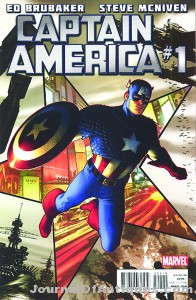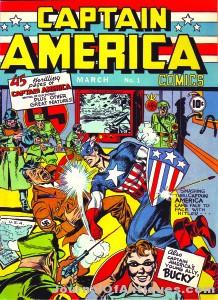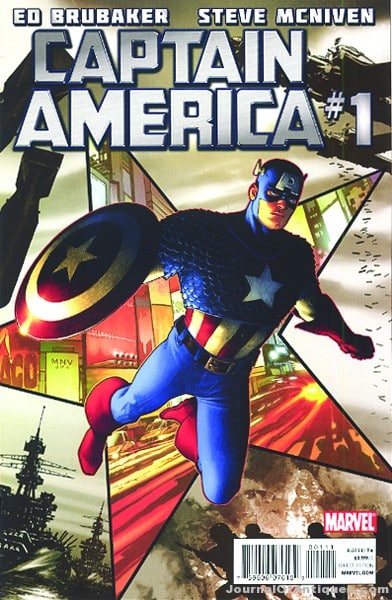What’s Old Is New Again: Captain America and Comic Book Reboots
By J.C. Vaughn

A lot of times it works. Sometimes it turns out like Johnny Depp’s turn in The Lone Ranger. Either way, the phrase of the day is “reboot.”
The most recent large scale reboot in the world of comics was DC Comics’ “New 52” initiative, which updated a large number of their characters in a coordinated relaunch. It attracted a lot of attention.
But truth be told, this is no different in concept than when Stan Lee and his “House of Ideas” created the “Marvel Age of Comics,” or when DC editor Julie Schwartz heralded the Silver Age by rebooting the Golden Age incarnations of DC’s top superheroes.
The excitement of DC’s then-new Flash and Green Lantern in the dawn of the Silver Age led to a wholesale revival of the company’s superhero line. Even the company’s premiere super-team, the Justice League of America, was a modernization of the first superhero team, the Justice Society of America.
Marvel, for its part, sometimes used only the names of the characters, seeing the Golden Age android Human Torch replaced by the young Johnny Storm Human Torch in the pages of Fantastic Four #1. Not too many years after that, the names Vision and Black Widow resurfaced at Marvel with little relation to the originals.
When the character Captain America was revived in Avengers #4 and when the Sub-Mariner appeared in Fantastic Four #4, they were not new versions of the characters but instead were the originals. The story of Captain America’s disappearance and his sidekick Bucky’s demise at the end of World War II, though, did in fact create the need for a substantial retro-continuity change since in the real world Cap’s adventures had continued through the end of the war and even experienced a strange, brief revival in the 1950s. It took many twists and turns over more than a decade of real time to fill in the continuity gaps and explain what had happened. The Sub-Mariner’s youth and vitality decades later was an easier explanation. As a human-Atlantean hybrid, a mutant, he had a longer lifespan as well as incredible power.

All of these instances of ret-con (retro continuity) or reboots provide natural jumping on or jumping off points for fans. Some of the fun may come in trying to figure out when a title has been changed just to get the spike in sales thought to accompany a new first issue, and when it’s really starting over. Marvel’s Captain America might be a great case study in this.
The recently launched “Marvel Now” series Captain America will be the tenth on-going title to feature the Star Spangled Avenger. While some of them have been short-lived, others have spanned decades. They include Captain America Comics (1941-1950, 1954), Captain America (1968-1996), Captain America (1996-1997, “Heroes Reborn”), Captain America (1998-2002, “Heroes Return”), Captain America: Sentinel of Liberty (1998-1999), Captain America (2002-2004, “Marvel Knights”), Captain America and The Falcon (2004-2005), and Captain America (2005 – 2011).
Following Captain America #50, the 2005 series took the cumulative issues and adopted the number of the 1968 series, making the following issue Captain America #600 in keeping with the character’s raised profile, Marvel’s 70th corporate anniversary, and the then-upcoming Marvel Studios Captain America film.
Following Captain America #619, Marvel decided to introduce a new Captain America series with Captain America #1 (the ninth series), so Captain America (eighth series) changed its title to Captain America & Bucky with #620, followed by Captain America & Hawkeye (one story arc), Captain America & Iron Man (one story arc), Captain America & Namor (one issue), and Captain America & Black Widow (one story arc).
Of these, Captain America Comics and the Silver Age Captain America represent two different takes on the same character, with the anomalies of the 1950s revival explained away with new story elements later. After that, the only distinctly different Cap prior to “Marvel Now” was the “Heroes Reborn” version, although the Marvel Knights version didn’t entirely square with other stories.
Regardless, there’s fun to be had in collecting any or all of them. Even if you can’t quite figure them all out.
J.C. Vaughn is the Vice-President of Publishing for Gemstone Publishing. He says he sadly enough does understand all the different volumes of Captain America. Scott Braden contributed to this article.





Related posts: